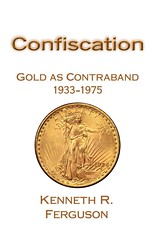
PREV ARTICLE
NEXT ARTICLE
FULL ISSUE
PREV FULL ISSUE
NOTES FROM E-SYLUM READERS: APRIL 22, 20181796 Dime Embedded in a Ladle  Ron Guth of San Diego, CA writes: The coin in the eBay ladle submitted by Phil Mernick is a 1796 Dime (JR-6). Considering that it show most of the die cracks associated with that variety, it is most likely real. Thanks! I was thinking it was a quarter, but a dime makes more sense given the relative size. The die cracks are important diagnostics. Neat item! Great for serving the gravy at a numismatic dinner
gathering. -Editor
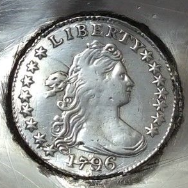 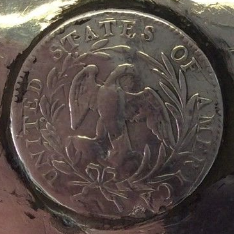 To read the earlier E-Sylum article, see: Gold In Commerce in the 1970s
Each of his four children got a coin (I still have mine), his church got at least one, and the rest were sold. The dealer recommended that he sell them periodically to not flood the market so he must have had enough to be of concern. As the price of gold was climbing, it also improved his bottom line. This was shortly after gold was again allowed to be sold but the man who paid the commission must have held the coins for many years. I will be purchasing the book to see if this was illegal in those days and to learn more about this part of history. To read the earlier E-Sylum articles, see: Father-Son Mint Engravers ANA Seminar Class There is a class at the ANA Summer Seminar that we are teaching: The Legacy and Coinage of Father-Son Mint Engravers William and Charles Barber. It is during Session 2, between June 24-28. For more information on the fabulous annual American Numismatic Association Summer Seminar, see the earlier article. -Editor
To read the earlier E-Sylum article, see: 2018 ANA SUMMER SEMINAR (http://www.coinbooks.org/v21/esylum_v21n05a22.html) An Aragon Ballroom Encased Franklin Half I just came across an Aragon Ballroom Encased Franklin Half Dollar with some of my mother’s coins. She lived in Santa Monica from 1935 - 1973. A Google search brought me to your article. Since you asked anyone who has seen similar encased coins to contact you, I thought I’d send you a picture. It’s the same as one you listed, a 1953 Franklin half dollar in a clear encasement with red writing from Aragon Ballroom. 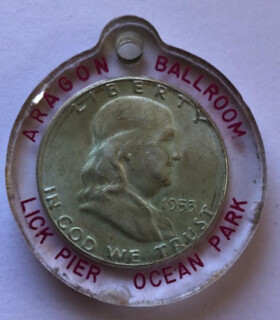 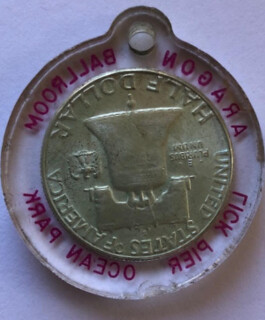 Thank you! -Editor
To read the earlier E-Sylum articles, see: Beware Translated Names! One of my gripes about historians is the translation of people’s names. I maintain that the name someone was given in his or her native land cannot and should not be translated — doing so only confuses things. See Gary's article, linked below, for background. Gary raises many legitimate points to consider. Reader Martin Purdy of Upper Hutt, New Zealand is a translator by trade and offers these thoughts on
the topic. -Editor
I don't want to go into this in depth or I may never stop - it's a bit of a minefield. I agree that we're steadily moving away from the habit of translating names, but it's a long process and not always easy or even practical - especially with regard to multi-lingual countries. Do we want to refer to the capital of Belgium in triplicate every time (Bruxelles/Brussel/Brüssel) because the country is officially trilingual and we mustn't leave any of its language groups out? Or indeed the country itself (Belgique/België/Belgien)? And could we ever get English speakers to cope with referring to Egypt as Misr, since that's what it is in Arabic? It's one of those case-by-case things, where historical practice is best adhered to, depending on the period, places and personages involved. It's been standard in English to refer to "Ferdinand and Isabella" for 500 years, and it would create more confusion to go changing it now. Different languages have their own practices in this regard, too - as evidenced by the Spanish-language examples your contributor quotes. I'm in the language business, and watching what makes other languages tick has been a source of pleasure and mental exercise since I was a child. Dabbling in Hungarian in recent years, I was briefly puzzled by a reference to "Tüzföld", which I first translated into English as "fire-land"; that didn't make much sense, and I had to go a step further and render it into Spanish to get Tierra del Fuego - success! Call me a masochist ("OK, you're a masochist!"), but I really don't want to be denied that pleasure. Something else to bear in mind is pronunciation - each language creates its own "shape" in the inside of your mouth, and having to stop and re-form to give a foreign name its "authentic" pronunciation in the middle of an English sentence is awkward at best, and bordering on the pompous at worst. It's a requirement with Maori names here in NZ now, and the poor old radio and TV announcers tie themselves in knots trying to get it right, and in most cases still either overdo it or make a mess of it. Do we as numismatists and historians want to have to learn the pronunciation rules of several dozen languages to be able to honour the original forms of every historic or foreign name we encounter? Thank you. For multitudes of reasons, few things in human endeavor are truly simple. I think my headline for Gary's article sums it up well, and I'll leave it at that: Beware translated person
and place names. To quote Facebook, "It's complicated." -Editor
To read the earlier E-Sylum article, see: Oldest Mintmark in the U.S.? Ron Guth pointed out this tweet by David Zanca of Blanchard Gold. -Editor
 Today, the San Francisco Mint is the largest producer of #collectible #coins in the U.S. and the largest proof #coin producer in the #world. It also has the #unique distinction of having the oldest mint mark in the U.S. http://ow.ly/sVRy30jxTHt Ron adds: The New Orleans, Dahlonega, and Charlotte mintmarks are "older" than San Francisco's. Perhaps they meant the longest surviving mintmark. The tweet links to an 1857-S double eagle recovered from the SS Central America. Blanchard is also selling raw gold recovered from the wreck in a novel format - see the separate article elsewhere
in this issue for more information. -Editor
To read the original tweet, see: World Book Night It’s World Book Night April 23rd. What? You never heard of it? Well it’s not celebrated in America like it is in a couple countries in Europe. There is also World Book Day, which has a couple names, International Day of the Book for one, World Book and Copyright Day for another. It was organized by UNESCO to bring recognition to publishing and copyright and encourage reading. It was first celebrated in Spain where April 23 was chosen as Cervantes death date, which by coincidence was Shakespeare's date of death as well, but not the same year of course. In England it was moved to the first Thursday in March for a conflict with Easter and is most actively celebrated in schools to promote reading to youngsters often in creative ways. It’s almost unheard of in America. But book publishing and marketing is not overlooked. Over 65 book fairs are held in yearly in America. Often these are specialized, as antiquarian books, or of a topic. It’s like multiple book stores in one location. I have frequently found numismatic books at such fairs. For more information, see: Wayne Homren, Editor The Numismatic Bibliomania Society is a non-profit organization promoting numismatic literature. See our web site at coinbooks.org. To submit items for publication in The E-Sylum, write to the Editor at this address: whomren@gmail.com To subscribe go to: https://my.binhost.com/lists/listinfo/esylum All Rights Reserved. NBS Home Page Contact the NBS webmaster 
|
